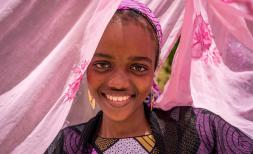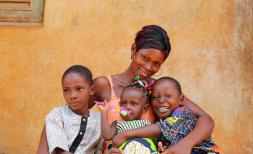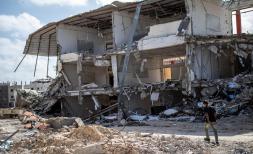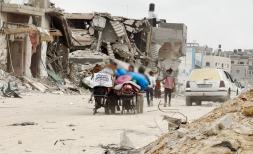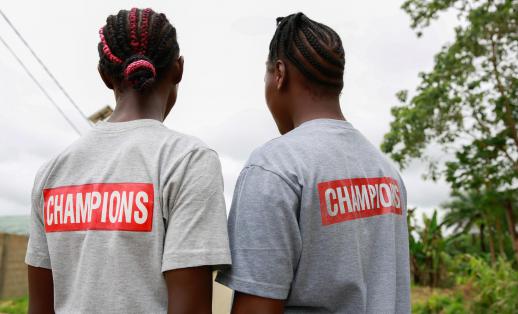Countdown to the Global Refugee Forum: A Spotlight on Jordan
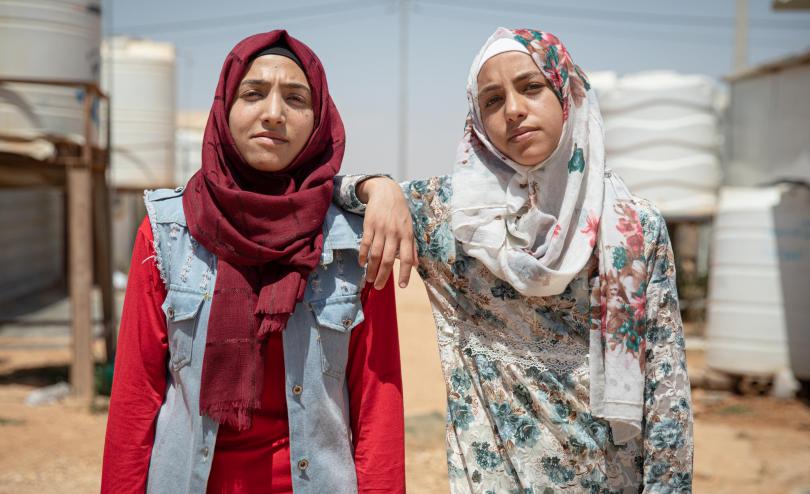
Hiba, 17, and Rama, 14, pose for a portrait in Za'atari camp for Syrian refugees, Jordan. Jordi Matas/Save the Children.
In December 2023, leaders from across the globe will gather for the 2nd Global Refugee Forum, it is a landmark opportunity to deliver decisive action for refugee children. Earlier this year, Save the Children published a new report – The Price of Hope - detailing the progress made on refugee education since 2019. This blog series is counting down to the start of the GRF with a deeper dive into some of the top refugee hosting countries, starting with Jordan.
“I keep telling her that we will achieve great things and the world will know about us” - Hiba 17-year-old and her younger sister Rama who is 14-years-old live in the Za’atari refugee camp in Jordan.
The two talented Syrian sisters took part in Save the Children and Arsenal’s Coaching for Life programme. It uses specially developed football training to build children’s courage and inner strength, and empower them to stand up for their rights. The sisters have been writing their own raps on ending early marriage and have been making a difference in their community by campaigning on this matter. The sisters are clearly capable of big things and access to a quality learning environment is essential to helping them achieve their dreams.
WHAT IS THE SITUATION IN JORDAN?
Jordan is surrounded by nations in conflict, making it host to one of the world’s largest global refugee populations, hosting 3,004,772 refugees. Over 2 million of which are Palestinian refugees registered with UNRWA, mostly displaced due to the 1948 and 1967 Israel-Palestine conflicts. A 2017/18 survey found that 99% of Syrian children aged 6-11 were enrolled in a school, whether in a camp or not. Sadly UN figures show a sharp decline in enrolment, as low as 25%, for secondary school children. While there is a certified programme that offers a route back to education for those who have been out-of-school for a significant period, there is little uptake.
As an older refugee population, Palestinian refugees are more established in Jordan with most holding citizenship and 83% living in housing outside of refugee camps. The country is home to two Syrian refugee camps, the Za’atari camp housing 80,000 refugees, and the Azraq camp housing 40,000 refugees. The sustainability of the Za’atari camp remains in question as it has now been running for over a decade, with many refugees reporting structural issues and inadequate access to essential utilities.
BARRIERS TO EDUCATION FOR REFUGEE CHILDREN
The inclusion of refugees in the Jordanian education system varies across contexts, despite them being included in principle. Refugee children engage in a number of ways; some being mainstreamed into Jordanian schools, some taught in second shifts and, others taught separately in camp settings. The second shifts generally offer a lower quality of education as they have access to fewer resources and teaching staff, whilst also dropping classes deemed less important such as art.
SLOW ECONOMIC GROWTH AND PUBLIC DEBT THREATENS EDUCATION
The Jordanian economy has recovered from the stress of the Covid-19 pandemic, though the country has never recovered from the 2008 global financial crisis and financial stress of the subsequent Arab spring. By the final quarter of 2022, over 80% of refugee households were in debt and unable to cover basic needs with their own income, and around 90% took negative measures including some who withdrew their children from school.
The IMF has forecast slow economic growth for the next few years, placing the education of millions of children in the country at risk. Jordan’s public debt troubles have persisted for over a decade, reaching approximately 14.7% of the GDP at the end of 2022. These conditions threaten the spending needed on key educational infrastructure as paying off unsustainable levels of public debt are prioritised, with just 2.9% of the GDP being spent on education in 2020 and 5.9% spent on external debt servicing alone.
The economic situation in Jordan leads to greater levels of poverty, which exacerbate education inequality, especially for marginalized groups such as refugees. Poverty is a persistent barrier to school, particularly for refugee children of secondary school age. These children are often forced into child marriage, child labour, or cannot afford the transportation fees to school.
Administrative and legal barriers also make it more difficult for refugees to access the Jordanian education system. Although sometimes waived, Syrian children typically require a ‘service card’ to enrol in school, these cards are issued by the Interior Ministry but are specific to certain districts, meaning if a family moves the card is no longer valid in a new district.
Additionally, some legal barriers that are waived for Syrian refugees are not waived for non-Syrian refugees, who face even more significant issues in getting the legal documentation required to access formal education.
These barriers are denying refugee children access to the life-saving and protective impacts of a quality education in a safe school environment. The international community must mobilise at the upcoming GRF to deliver bold action that ensures an education for every last refugee child, in countries like Jordan.
FIVE THINGS SAVE THE CHILDREN WANTS TO SEE AT THE 2023 GLOBAL REFUGEE FORUM
- Make the promise of the Global Compact on Refugees a reality. The Global Compact provide blueprints to ensure that refugees, as well as host communities, get the support they require to meet their education needs. We must not waste this opportunity.
- Put refugee children at the heart of the Global Refugee Forum. They are experts on the challenges they face, their safe and meaningful participation must be prioritised.
- Prioritise matched pledges to advance responsibility sharing. Educating refugee children is a global public good and must be a shared global responsibility.
- Pledges must be meaningful, accountable and actionable. It is imperative that all pledges include timelines for completion and measurable targets and indicators so that progress can be properly tracked.
- Focus on the money needed to ensure all refugees have access to quality education. Opening education to all refugee children and including them in national education systems can be achieved at an estimated annual cost of US$4.85 billion globally.
